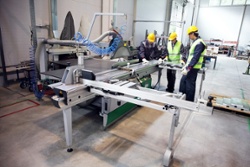
How Lean Fabrication Manufacturing Impacts Your OEM Supply Chain
November 10, 2017
 Lean manufacturing is remarkably effective at creating continuous part flow and reducing waste when your custom steel fabricator has all of the fitting pieces in place. However, every process has to work together to create greater overall efficiency.
Lean manufacturing is remarkably effective at creating continuous part flow and reducing waste when your custom steel fabricator has all of the fitting pieces in place. However, every process has to work together to create greater overall efficiency.
The Fabricator magazine explains why the institution of just one change won’t significantly impact fabrication manufacturing efficiency.
For example, custom steel fabricators that target 5S practices help to improve visual management and organization on the shop floor, but 5S is merely a building block for other lean manufacturing tools and methodologies.
The key is to not just observe the visual impact on your metal manufacturer’s floor but to seek how their lean practices affect your project. Lean manufacturing truly becomes an effective system, rather than an improvement here and there, when an OEM fabricator combines 5S with the following practices:
- Quick machine changeover
- Focus on parts flow
- Understanding of capacity
- Sales and operations planning
- Level loading
- Smart information flow
- Smart inventory
If you’re getting ready to partner with a new OEM fabricator, you can best ascertain the extent of their lean manufacturing system through a quality audit during a plant tour.
Designing Efficiency For Maximum OEM Impact
A metal manufacturer can lay claim to achieving high efficiency gains, but these gains may not necessarily have a pronounced impact on your OEM operations unless they’re designed around your needs.
For example, in 2009, the team at Miller Fabrication Solutions set out to improve OEM parts production time. A single-piece flow model was implemented to replace batch-and-queue processing. This implementation removed wait times in between processes, thereby speeding up production and translating into time savings for OEMs.
The OEM Supply Chain Effect
To determine if an OEM supplier’s initiatives are designed properly for your needs, consider whether your OEM parts are delivered:
- In the right size
- In the right quantity
- At the right time
- With minimal-to-no defects
Moreover, these results should be evident on a consistent basis. Talk with existing customers to understand the service level they expect and how their custom steel fabricator matches up. Ask for customer survey results, Net Promoter Scores and other forms of measurement to identify any efficiency breakthroughs noted among their larger customer base.
Also, get to know how the OEM supplier is enacting continuous improvement, and what their goals are for the next quarter, next year and beyond. By completing extensive due diligence, you will get a better sense of the lean impact you can expect on your OEM parts projects over the long haul with your strategic metal manufacturer.